However, as the efficiency of a boiler or water heater increases, more heat from the combustion process must be transferred into the water at the heat transfer surface. The relative temperature of the flue products decreases as the efficiency increases.
When the flue products from the combustion process are excessively cooled, they will reach their own dewpoint, which is the temperature where the water vapor and products of combustion condense into a liquid. This liquid collects on both the heat transfer surfaces and in the flue.
Condensate Hazards
Flue gas condensate is acidic (approximately 4 to 5 pH) and can cause major operational, installation, and safety issues when allowed to continue forming in a boiler or water heater that is not designed to condense.A small amount of condensate may have little effect on initial operation. However, as the volume of condensate formed increases, it can have major detrimental effects on operation.
Condensate obstructs the path of flue products on the heat transfer surface, fouls burners, damages ignition devices, attacks the jacket and related components, and collects in the flue pipe. Flue gas condensate can attack and destroy the venting system. Corrosion of the venting system can create a potentially dangerous condition to the point where flue gas spillage can occur.
Excessively cooled flue products can also result in a loss of draft and spillage of flue products into an occupied space, which causes another potentially dangerous situation.

The Role of Minimum Inlet Water Temps
The formation of condensate is controlled by regulating the minimum inlet water temperatures for both boilers and water heaters. ANSI Standard Z21.13, “Gas-Fired Low-Pressure Steam and Hot Water Boilers,” contains a chart that relates the approximate dewpoint temperature of gas flue products to the combustion process. (See Figure 1.)As gas combustion occurs, the byproducts are principally water vapor and carbon dioxide (CO2). Figure 1 shows the relationship between the CO2 concentration in the gas flue products and the dewpoint temperatures of flue products by providing curves for both natural and LP gas.
Assume that you’re operating a typical high-efficiency, natural gas-fired boiler with a CO2 level of 7.5% in its flue products. By plotting this on the curve, you can determine that the dewpoint for the flue products from this boiler would be approximately 125°F.
Note: The chart assumes typical conditions regarding the combustion air temperatures, barometric pressure, and relative humidity, based on laboratory testing. In real-world applications, these conditions may vary. Typically, this dewpoint temperature is slightly increased to provide a safety factor to compensate for the varying real-world conditions in order to establish a minimum inlet water temperature to control condensation.
Correct Temperatures
A typical mid-efficiency boiler or water heater operated with water temperatures in the range of 130° to 140° will prevent condensate problems.Note: A water heater must use a thermostatic mixing valve to provide lower-temperature domestic water in order to prevent a risk of scald injury. This has proven to provide reliable temperatures to control condensation based on years of application in the field.
If the minimum inlet temperature to the boiler or water heater is maintained above the minimum dewpoint temperature, condensate is controllable. It is virtually impossible to cool the flue products to dewpoint when the minimum inlet water temperatures are maintained above the dewpoint temperature based on this data.
By controlling minimum inlet water temperatures, we are able to prevent unwanted condensation. This ensures consistent operation of a high-efficiency boiler or water heater, and provides reliable operation of a standard venting system.
Moore is manager of technical services for Lochinvar Corp., Nashville, TN; www.lochinvar .com (website).
Publication date: 03/26/2001

Report Abusive Comment